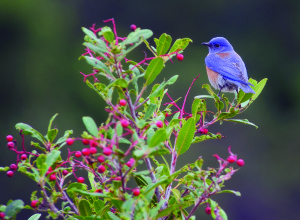By Georgette Howington
Special to the Herald
Rarely seen 30 years ago because of severe population decline, the Western Bluebird, once a common harbinger of spring is making a comeback in the Bay Area. Nest box monitors, taking care of birdhouses season-after-season, smile when they hear news like, “I saw a bluebird for the first time!” or “There are more bluebirds in the open space these days.” So, what’s going on?
Urban adaptation due to mature trees, grassy areas (gardens, golf courses, parks and dedicated open space), more places for successful nesting such as monitored birdhouses and the reduction of insecticides are some of the contributing factors. Scientific studies indicate varied results in populations of Western Bluebird (Sialis Mexicana) depending upon locale within the North American Western Region. For instance, in 2016, the IUCRedlist of Threatened Species (www.iucredlist.com) lists the species as “Least Concern.” The Audubon Society (www.Audubon.org), on the other hand, published the species as “Threatened” due to climate change.
In 1995, Don Yoder, and a small group of bluebird enthusiasts, with support from the Mt. Diablo Audubon and the North American Bluebird Societies, formed the California Bluebird Recovery Program. “For the encouragement and preservation of cavity-nesters – especially bluebirds anywhere in the West.” has clearly lived up to that vision. With fewer than 200 reporting monitors the average annual fledgling count since 1996 is 154,770.
Bluebird nest boxes are designed for Western Bluebirds, Chestnut-backed Chickadees, Titmice, Ash-throated Flycatchers, Tree Swallows, Violet-Green Tree Swallows, White-breasted Nuthatches and House Wrens. The detailed design is critical for this group of birds. Barn Owls and Wood Ducks are examples of other secondary-cavity nesters that can adapt to using nest boxes but theirs are much larger.
Nesting season begins late-January and is over about late August. In fall and winter, after the boxes are cleaned out, the birds often use them for roosting.
Monitors learn how to safely check the nest boxes, keep records and turn their data in to CBRP at the end of the nesting season. It’s best not to install nest boxes if they are not going to be monitored.
For more information, please, check out www.cbrp.org and contact a county coordinator.
Georgette Howington is the state assistant program director and Alameda and Contra Costa counties coordinator for the California Bluebird Recovery Program.







Are there bluebirds in Benicia?